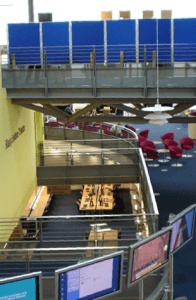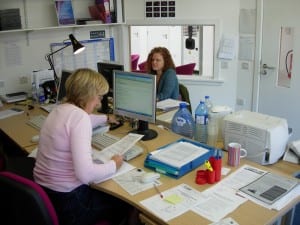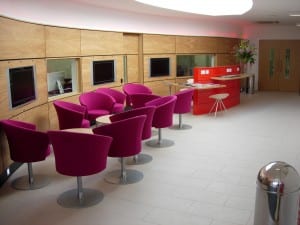Edinburgh Napier University: The Screen Academy
Innovation
The focus of the case study at Edinburgh Napier University is the Edinburgh Skillset Screen and Media Academy (The Screen Academy). The Screen Academy is one of seven centres of excellence for film practice in education in the UK and is backed by Skillset, the UK Film Council Lottery, The Scottish Executive, the Scottish Media Group and BBC Scotland. The Screen Academy was developed in collaboration with Edinburgh College of Arts and is home to most of the university’s undergraduates and postgraduate media production and film students. The Screen Academy offers programmes such as film directing, producing, screenwriting and animation, as well as a growing range of short courses and continuing professional development courses for people already in the industry. As a result the Screen Academy has close links with the media industry, the local community, and a number of other higher education and further education institutions.

The Screen Academy, Napier University
The Screen Academy is located at the university’s Merchiston campus and is situated in a single storey building, which was previously a garage before becoming a renovated teaching space. The underpinning philosophy of the space is to provide an environment with a professional ambiance that allows for informal social interaction between students, staff, and professionals from the media industry.
The Screen Academy contains the latest equipment as well as the capacity to easily adapt to technological advancements. Internally, the space is made up of a number of multipurpose teaching rooms, audio and video recording studios, technical storage space, technicians and administration offices, and a main social meeting space in the centre of the building. The social meeting space is the heart of the Screen Academy and contains a central seating area with sofas, and has been described as being ‘…symbolically the most important space because it has created a focal point’ (Senior Academic). This space is well illuminated by natural radiance from a roof light, and is well used by students, staff and professionals from the industry. The space also has high impact when external visitors come to the Screen Academy, with a series of highly visible flat screen monitors, which displays the students’ work ‘…the place has the feel of arriving in a professional environment’ (Senior Academic).
The space is well liked and heavily used ‘…the Head of School, the students and the College of Art all really like it’ (Senior Manager), and ‘…there is a real sense of ownership of the building and a pride in its functioning…as well as a sense of coherence to the space’ (Senior Academic). The Screen Academy is also used for hosting industry events for the Edinburgh International Television Festival and the BBC, which fits precisely how the user group wanted the space to be used ‘…a space where we could put on events for the wider community, including public screenings’ (Senior Academic).
Visions and Missions
Edinburgh Napier University has grown out of an amalgamation of local colleges and still has strong links with the further education sector in the area. Edinburgh Napier became a university in 1992 and as such, the university sees itself as a ‘modern’ institution with the ambition to be one of the best modern universities in Scotland’ (Senior Manager). Despite the university’s ambition to be one of the best modern universities, its physical campus does not express this desire ‘…we are a modern university but we have some very tired looking 1960’s and 1970’s buildings, but we are working towards a position where our architecture can articulate our vision’ (Senior Manager).
Consequently, the university is considering improving its physical campus to give it a much more ‘modern’ feel as well as making its campus much more coherent ‘we used to be all over the place, but now we have a plan to achieve greater coherence’ (Senior Manager).
The university is very clear about where its focus should be: ‘we are definitely learner focused…with strong links to the employment sector and industry requirements…we are orientated to ensuring that our graduates get jobs…research is very much a secondary issue’ (Senior Manager). The university is very clear about its vision, and views it as it one of strengths, realising that it would find it difficult to compete with more established research intensive universities ‘…it is about asking the questions about what you are, rather than asking the question about what ,in theory, you might want to be’ (Senior Manager).
Leadership and Governance
The university has a central decision making process, which is overtly ‘managerialist’. As such, the university’s approach to leadership is formal, but is heavily based on networks between departments and individuals ‘…we subscribe to a formal approach to leadership, which involves matrix management…in other words, making connections across various issues, without trying to structure everything into big hierarchies’ (Senior Manager).
At the organisational level, a significant element of making these connections with regard to space planning is done through the university’s committee structure, and specifically, dedicated committee groups such as the newly developed Infrastructure Development Committee, which is comprised of senior managers, estates, and academics ‘…we used to have a committee called the Space Management Committee, which was a bit limiting, so know we call it the Infrastructure Development Committee because it has responsibilities beyond just managing space. We make sure that we understand what is going on and that we agree on the rules of the game’ (Senior Manager).
In addition to this, the university also has a Space Management Group and Estates Policy Committee where strategic projects are discussed and recommended before being sent to the university Court for sign off and approval.
The university has a good level of engagement with members of staff and students outside of the organisational structure, but still has a very central drive towards decision making ‘…we do not live with a disabling democracy, it is not about having a million solutions that do not fit together’ (Senior Manager). However, the university does consult with members of staff and students ‘…we do have a fairly good level of engagement, so it is not that we do not discuss or have forums for people to contribute, it is just that we do not tie ourselves up in knots about how we make a decision…consultation is what it says…we consult and then we decide’ (Senior Manager).
This has resulted in an interesting form of managerial and estates leadership that engages staff and students and is supported by research ‘…we use market research based techniques and ask students and staff what they think needs doing the most’ (Senior Manager). This approach was used to develop the university’s estate strategy that runs until 2016 ‘…when we drafted the estates strategy we had a working group within which the academic areas of the university were well represented, there were not any decisions made that they were not involved in’ (Estates). As such, the estates department sees themselves as ‘the custodians of the buildings’ (Estates), with the task to try to support staff and students in the development of space that enhances their teaching and learning endeavours ‘…we try and create spaces that academics and students tell us they would like to be created’ (Senior Manager).
Developing the Brief
The idea for the Screen Academy came from the desire to improve the university’s media facilities and to create a centre for excellence in postgraduate film production. A bid was submitted to Skillset in collaboration with Edinburgh College of Arts in 2004 with the idea to have the project complete for the Edinburgh Festival in August 2005, giving the project team a short period of time to design and built the Screen Academy.
The next stage was for the project team to develop a brief which was done with consultation with academics, estates, and the project manager working through a very detailed process. The result was that there was a high degree of clarity and ownership about what was trying to be achieved.
This design process was supported by site visits to other universities with the user group, estates, project managers, and estates to help develop the brief. What was interesting about these site visits was that the project team were very thorough in their investigation of the spaces they visited: ‘we would go and speak to whoever it is that can best tell us about the space, and the conception behind the space, and its problems…we try to learn from other people’s mistakes’ (Senior Manager).
In addition to this, the architect went to visit the original space at the university‘…we went to look around the original space and observed classes so we could get under the bones of what they were doing in these spaces’ (Architect).
Perhaps one of the most significant elements in the development of the brief was that the users knew what they wanted from the start ‘…there was a really clear imperative about what we wanted and everybody was able to buy into that. We knew exactly what we wanted to get, and I think that was made clear to the architects at the beginning as well’ (Senior Academic).
Moreover, there was a good level of dialogue throughout process as the brief was being developed: ‘…we had a very close dialogue and discussion with teaching staff about what we wanted in the space’ (Senior Academic). The project team was kept well informed about the detailed technological requirements for the space …the technicians were superb, they gave us detailed knowledge of exactly what they wanted’ (Project Manager).
And, as ever, the relationship with the architect played a significant part ‘…I have worked with quite a few architects on various parts of this project in this building and I would say that it was a very successful relationship’ (Senior Academic).
Project Management

Interior
The project manger was involved in the development of the project right from the start and developed a comprehensive approach to the project. This meant that ‘…we were able to be very clear to the contractors about what we wanted to achieve, and they were very clear in the way that they were going to achieve it…because of this communication was very good on both sides’ (Senior Academic). The rationale for this approach was explained by the project manager ‘…to make sure that the project comes together you have to get everything tied down before you hand it over to the contractor’ (Project Manager). This included regular meetings with the user group, contractors and the architect ‘…we met every two weeks and I wanted full team attendance, so we wrote each meeting into the consultants tenders’ (Project Manager).
The project stage of the Screen Academy was further helped by getting the right design team and constructors for the job ‘…there are two critical aspects of a construction project – first you must get the right design team, and we had a great one – second you must get the right contractor…if you do this you minimize the risk of the project’ (Project Manager). In addition, this was further helped by good communication between the project team and users: ‘I nominated someone from the department to act as communication person who would sit on our meetings, their job was to make sure that anything that they felt was relevant to their department they went back and told them’ (Project Manager).
Post-project Evaluation
The Screen Academy appears to be successful and is well used by staff, students, and professionals from the industry. There has been no formal evaluation ‘…we did not have any formal evaluation about how the students felt about this place as compared to their facilities before…there is already a system of student feedback and there is module feedback…we did not receive any negative feedback’ (Senior Academic). Much of the evaluation has come through meetings ‘…we do have project meetings and we will discuss the things that worked well and things that have not worked well’ (Estates). One of the most effective methods of evaluation has been through informal dialogue ‘…talking to people has been the main way of evaluating the space’ (Senior Manager).


Recent Comments